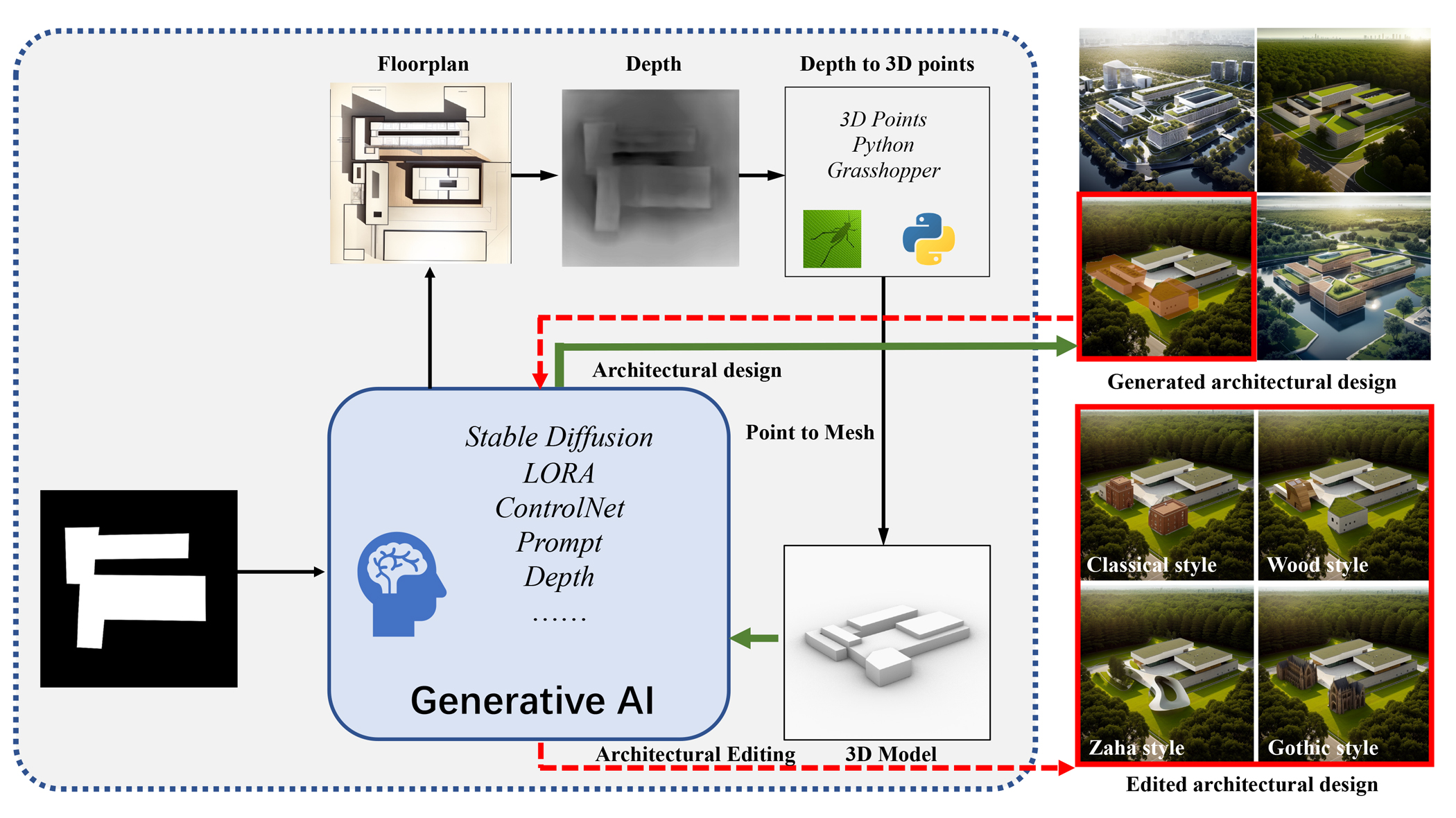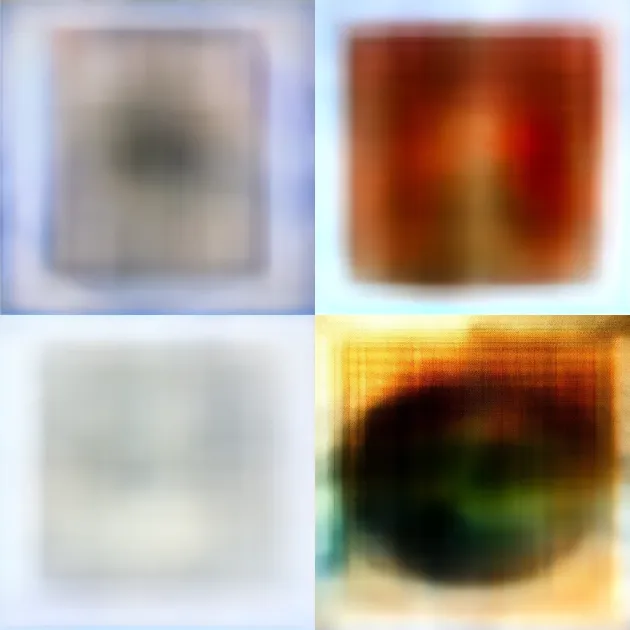Layout2Rendering: AI-aided Greenspace design

0
❗
Sign in to get full access
Overview
- This paper proposes a deep learning-based system for generating park space designs based on the topological relationships of landscape elements.
- The system can rapidly generate 3D landscape models that meet designers' requirements, while also providing analysis and visualization tools for iterative design.
- The key innovations include vectorizing and 3D-izing landscape elements using semantic information, and integrating the generative and analysis components into an interactive workflow.
Plain English Explanation
Landscape designers often create 3D models to visualize how different design elements will fit together in a space. However, generating these detailed 3D models can be time-consuming and challenging, especially for complex natural environments like parks. This study proposes an AI-powered system to help automate this process.
The core idea is to use deep learning to analyze the relationships between different landscape features, like trees, paths, and water features. Based on this analysis, the system can then automatically generate a full 3D model of the proposed park design. This allows designers to rapidly explore different layout options and see how they would look in a realistic virtual environment.
Importantly, the system also includes tools for analyzing the generated designs, such as visualizing pedestrian flow or shaded areas. This makes it easier for designers to identify issues or optimize their designs in an iterative process. The use of AI-assisted generative design is an active area of research in architecture and design.
Overall, this technology aims to streamline the landscape design process by automating the tedious 3D modeling work and providing real-time feedback on design concepts. This could help designers be more efficient and creative in developing functional, visually appealing public spaces.
Technical Explanation
The researchers developed a deep learning-based system that can generate park space designs based on the spatial relationships between landscape elements. The system takes in basic site conditions as input and outputs a detailed 3D model of the proposed park layout.
Key components of the system include:
-
Landscape Element Vectorization: The researchers developed methods to automatically convert various types of landscape elements (e.g. trees, paths, water features) into vector-based representations that capture semantic information about the elements.
-
3D Model Generation: Using the vectorized landscape elements, the system can then generate a full 3D model of the park space using tools like Grasshopper. This includes automatically adjusting parameters to create a realistic and visually appealing result.
-
Landscape Analysis and Visualization: The generated 3D models are analyzed to produce visual insights, such as pedestrian flow patterns or shaded areas. These analysis tools allow designers to iteratively refine their designs.
The researchers note that this approach contrasts with prior generative design systems that relied more on parameter restrictions. By focusing on the topological relationships of landscape elements, their system can generate more natural and contextually-appropriate designs.
Experiments demonstrated the system's ability to rapidly produce park space designs meeting designers' requirements, as well as the value of the integrated analysis and visualization capabilities for supporting an interactive design process.
Critical Analysis
The paper presents a promising approach for using deep learning to assist landscape designers, but a few potential limitations are worth considering:
-
The system's ability to generate truly novel, creative designs may be limited if it relies too heavily on existing design patterns captured in the training data. More research is needed on generative AI systems that can push the boundaries of design in transformative ways.
-
The accuracy and reliability of the 3D modeling and analysis tools will be critical for designer trust and adoption. Ensuring these components are robust and high-fidelity will be an important area for future work.
-
The paper does not address how the system would handle real-world complexities like regulations, budgets, and stakeholder input that are essential considerations in actual landscape design projects. Integrating the generative capabilities with these practical constraints remains a challenge.
Overall, the researchers have made an interesting contribution by demonstrating how AI-powered generative design can be applied to the domain of landscape architecture. But there is still much work to be done to fully realize the potential of this technology in professional practice.
Conclusion
This study presents a novel deep learning-based system for generating park space designs. By focusing on the topological relationships between landscape elements, the system can automatically produce 3D models that meet designers' requirements. Importantly, the system also includes analysis and visualization tools to support an iterative design process.
The researchers have shown the potential of using AI to streamline complex design tasks and enhance designer productivity. As the field of generative design continues to evolve, this type of technology could become an increasingly valuable tool for landscape architects and urban planners seeking to create functional, visually striking public spaces.
This summary was produced with help from an AI and may contain inaccuracies - check out the links to read the original source documents!
Related Papers
❗

0
Layout2Rendering: AI-aided Greenspace design
Ran Chen, Zeke Lian, Yueheng He, Xiao Ling, Fuyu Yang, Xueqi Yao, Xingjian Yi, Jing Zhao
In traditional human living environment landscape design, the establishment of three-dimensional models is an essential step for designers to intuitively present the spatial relationships of design elements, as well as a foundation for conducting landscape analysis on the site. Rapidly and effectively generating beautiful and realistic landscape spaces is a significant challenge faced by designers. Although generative design has been widely applied in related fields, they mostly generate three-dimensional models through the restriction of indicator parameters. However, the elements of landscape design are complex and have unique requirements, making it difficult to generate designs from the perspective of indicator limitations. To address these issues, this study proposes a park space generative design system based on deep learning technology. This system generates design plans based on the topological relationships of landscape elements, then vectorizes the plan element information, and uses Grasshopper to generate three-dimensional models while synchronously fine-tuning parameters, rapidly completing the entire process from basic site conditions to model effect analysis. Experimental results show that: (1) the system, with the aid of AI-assisted technology, can rapidly generate space green space schemes that meet the designer's perspective based on site conditions; (2) this study has vectorized and three-dimensionalized various types of landscape design elements based on semantic information; (3) the analysis and visualization module constructed in this study can perform landscape analysis on the generated three-dimensional models and produce node effect diagrams, allowing users to modify the design in real time based on the effects, thus enhancing the system's interactivity.
Read more4/26/2024


0
Sketch-to-Architecture: Generative AI-aided Architectural Design
Pengzhi Li, Baijuan Li, Zhiheng Li
Recently, the development of large-scale models has paved the way for various interdisciplinary research, including architecture. By using generative AI, we present a novel workflow that utilizes AI models to generate conceptual floorplans and 3D models from simple sketches, enabling rapid ideation and controlled generation of architectural renderings based on textual descriptions. Our work demonstrates the potential of generative AI in the architectural design process, pointing towards a new direction of computer-aided architectural design. Our project website is available at: https://zrealli.github.io/sketch2arc
Read more4/1/2024
🛠️

0
Automated architectural space layout planning using a physics-inspired generative design framework
Zhipeng Li, Sichao Li, Geoff Hinchcliffe, Noam Maitless, Nick Birbilis
The determination of space layout is one of the primary activities in the schematic design stage of an architectural project. The initial layout planning defines the shape, dimension, and circulation pattern of internal spaces; which can also affect performance and cost of the construction. When carried out manually, space layout planning can be complicated, repetitive and time consuming. In this work, a generative design framework for the automatic generation of spatial architectural layout has been developed. The proposed approach integrates a novel physics-inspired parametric model for space layout planning and an evolutionary optimisation metaheuristic. Results revealed that such a generative design framework can generate a wide variety of design suggestions at the schematic design stage, applicable to complex design problems.
Read more6/24/2024


0
Automating Computational Design with Generative AI
Joern Ploennigs, Markus Berger
AI image generators based on diffusion models have recently garnered attention for their capability to create images from simple text prompts. However, for practical use in civil engineering they need to be able to create specific construction plans for given constraints. This paper investigates the potential of current AI generators in addressing such challenges, specifically for the creation of simple floor plans. We explain how the underlying diffusion-models work and propose novel refinement approaches to improve semantic encoding and generation quality. In several experiments we show that we can improve validity of generated floor plans from 6% to 90%. Based on these results we derive future research challenges considering building information modelling. With this we provide: (i) evaluation of current generative AIs; (ii) propose improved refinement approaches; (iii) evaluate them on various examples; (iv) derive future directions for diffusion models in civil engineering.
Read more5/6/2024